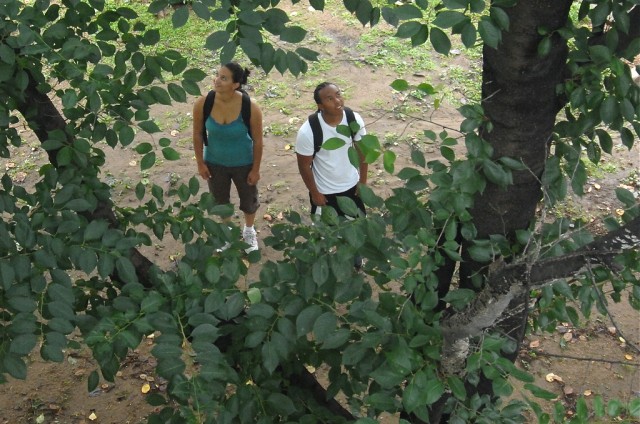
<strong>YONGSAN GARRISON, Republic of Korea</strong> -- While some students may pass their time this summer staying cool indoors, two summer hires with the U.S. Army Garrison-Yongsan Environmental Division Office have been outside since early June collecting data on birds living in the garrison.
Summer hires Alysia Lavender and Leland Lewis have the unusual, but rewarding, task of bird watching every workday from 8 a.m. to Noon, they said.
"I just took a class last semester about birds," Lavender, a college senior and biology major, said. "And bird watching is closely related to that."
Lavender and Lewis spend each morning walking around the base counting different species of birds and their numbers.
"We have been able to find a baby owl and hot spots where a lot of birds are gathered," she said. "It helps to know where they are, especially for environmental planning so their habitat is taken into consideration."
The bird-watching summer hires are equipped with binoculars, a digital camera, and bird guidebook. However, they have become so familiar with the birds that they can sometimes identify them by sound alone.
"After being around the birds so much, I can tell what kind of bird is around by their chirping," she said.
Bird watching may sound relaxing, but it requires a lot of time outdoors in the heat surrounded by bugs and the harsh sun. However, they say they are learning something in the process.
"I never really noticed any birds on base before," Lewis said. "But now I have more appreciation of them."
Garrison Environmental Division Office Chief Richard Mauser thought of the bird watching program in February as a way to monitor bird population levels on the base. Fluctuations in population could be a sign of environmental change, he said.
The most common birds on the garrison are Black-billed Magpies (called Kkachi in Korean) and Tree Sparrows (called Chamsae in Korean).
The garrison is also home to a small group of Ring-necked Pheasants (called Kkwong in Korean) and Black-naped Orioles (called Kkoekkori in Korean, which translated means "voice of a beautiful female singer"), Environmental Protection Specialist Kwon O-pong said.
"We want to raise awareness of Yongsan's natural resources," Mauser said of his bird watching initiative. "A lot of times we have our eyes closed to the environment around us, but there is a lot to see once we look for it."
Follow USAG-Yongsan on <a href="http://twitter.com/USAGYongsan">Twitter</a>, <a href="http://flickr.com/usag-yongsan/">Flickr</a> and become a fan on <a href="http://www.new.facebook.com/pages/USAG-Yongsan/32158407071">Facebook!</a> Learn more about serving in Korea at the <a href="http://yongsan.korea.army.mil/">USAG-Yongsan Web site</a>.

Social Sharing